|
|
 |
|
August 25, 2009
There are a number of theories about the meteoric rise of pinot noir as the beverage of choice among many wine enthusiasts. That movie gets much of the credit/blame, of course, but I have a slightly more altruistic notion.
I am of the humble opinion that pinots are simply better than ever, that grape growers and winemakers are more dialed in, and that pinot love simply needed a trigger, given that the world at large has always had a romance with red Burgundy.
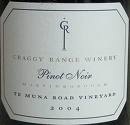 Evidence of my first point abounds. A few years back I discovered Black Kite, a small producer in California's Anderson Valley making stunning vineyard-designate wines. More recently I've been amazed by two Russian River/Sonoma Coast producers -- Sojourn and Freestone. Evidence of my first point abounds. A few years back I discovered Black Kite, a small producer in California's Anderson Valley making stunning vineyard-designate wines. More recently I've been amazed by two Russian River/Sonoma Coast producers -- Sojourn and Freestone.
And just the other day I had my assistant set up a tasting of 40 wines and was absolutely blown away by four vineyard-designate pinots from Craggy Range of New Zealand.
These four pinots (Bannockburn Sluicings, Zebra, Te Muna Road and Calvert) from the 2007 vintage, ranging in price from $39 to $50, are among the finest New World pinots I've ever tasted. They were strikingly consistent, and all four shared a few appealing similarities, most notably a strong thread of minerality throughout and floral notes that were consistent in all four wines.
I have reviewed them in this week's Reviews section and all four received ratings of 92 points or higher. Best of all, I believe these four from Craggy Range possess the ability to improve with age. Longevity is one aspect that has been missing from many New World pinots.
In fact, I believe all four will be performing admirably long after the memory of that movie has faded.
Posted by Robert Whitley at 11:45 AM
|
|
August 20, 2009
 Seems like everyone's taking the opportunity in these last few weeks of summer to cram in a column about white wines. Seems like everyone's taking the opportunity in these last few weeks of summer to cram in a column about white wines.
Eric Asimov over at The New York Times is waxing about Italian whites, in particular Vermentino. Asimov makes the point that a common perception is that Italy is awash in red wine, but that overlooks quite a bit of very good white vino.
Indeed, the white wines of Alto Adige, Friuli, Campania and even Sicily are some of my favorites, especially Greco and Fiano.
 Bill Daley at the Chicago Tribune tackles Sauvignon Blanc by any other name, in this case the Loire Valley's underrated and undervalued Quincy. Daley offers the Domaine du Tremblay as one of his top picks, and I would like to add that sauvignon enthusiasts who've not explored the Loire might find a few things to love in the Daley column. Bill Daley at the Chicago Tribune tackles Sauvignon Blanc by any other name, in this case the Loire Valley's underrated and undervalued Quincy. Daley offers the Domaine du Tremblay as one of his top picks, and I would like to add that sauvignon enthusiasts who've not explored the Loire might find a few things to love in the Daley column.
And finally, over at Wines & Vines, our good friend Linda Jones McKee takes a look at Pennsylvania's signature grape. Cab Franc? Viognier? Linda has some ideas.
Posted by Robert Whitley at 11:03 AM
|
|
August 19, 2009
I may not be your average American football fan. I don't spend my autumn weekends camped in front of the TV chugging a beer as I cheer on my favorite teams. Nope, it's usually a glass of vino.
So, friends often ask me what wines go with football. They usually do so with a wink and a smirk, but for me the issue is no joking matter. I'm dead serious about football and wine and have made it a lifelong study. There are subtleties at play most beer drinkers wouldn't understand.
For example, you must realize that football season kicks off in the midst of Indian summer, with warm, sunny afternoons that call for cool, crisp white wines such as pinot grigio, albarino, sauvignon blanc and riesling.
 That's for starters, and by that I mean these wines make wonderful mates for the snacks I serve early in the football afternoon at the beginning of the season: ceviche, spicy guacamole, bruschetta, and toasts with tapenade and/or goat cheese and sun-dried tomato. That's for starters, and by that I mean these wines make wonderful mates for the snacks I serve early in the football afternoon at the beginning of the season: ceviche, spicy guacamole, bruschetta, and toasts with tapenade and/or goat cheese and sun-dried tomato.
A few wine suggestions for this array of tapas: Ca' del Solo 2008 Albarino, Monterey County ($19) is a minerally example, perhaps the finest in the U.S., of this classic Spanish grape variety, with aromas of lime blossom and green apple and refreshing acidity; Ventana Vineyards 2008 Riesling, Monterey County ($18), technically an off-dry riesling, but so well balanced that it comes across as dry, making it a perfect match for the savory and slightly sweet aromas of the tapas; Matua Valley 2008 Sauvignon Blanc, New Zealand ($12) is simply the best bang for the buck in Kiwi sauvignon.
As the football season advances, the menu options acclimate to the cooler temps, and my football snacks trend toward hot dishes such as chicken chili, grilled chicken wings, bratwurst and more savory, pungent cheeses.
Of course, this calls for more robust wines. That would be heavier whites, such as chardonnay or viognier, and spicy reds that can stand up to stews and char aromas off the grill.
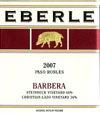 Wine suggestions for heavier, more wintry football faire: Bonterra 2007 Chardonnay, Mendocino County ($14) has the dual advantage of being exceptionally yummy for the money and organic, too, if you're into that sort of thing; Carmel Road 2007 Pinot Noir, Monterey ($16) is another tasty bargain wine, considering the price of pinot noir has gone through the roof. And if you get ambitious and grill up a salmon steak, you will be in sublime culinary territory no matter the score of the game; Eberle 2007 Barbera, Paso Robles ($22) would be a very classy addition to your game day, as it was Best of Show red wine at the 2009 San Diego International Wine Competition and would be right at home with a zesty chili or barbecued ribs; Sonoma Vineyards 2007 Syrah, Sonoma County ($15) is an impressive syrah for the money, but it's the second label of the stellar Rodney Strong Vineyards, so the quality level is hardly a surprise. Wine suggestions for heavier, more wintry football faire: Bonterra 2007 Chardonnay, Mendocino County ($14) has the dual advantage of being exceptionally yummy for the money and organic, too, if you're into that sort of thing; Carmel Road 2007 Pinot Noir, Monterey ($16) is another tasty bargain wine, considering the price of pinot noir has gone through the roof. And if you get ambitious and grill up a salmon steak, you will be in sublime culinary territory no matter the score of the game; Eberle 2007 Barbera, Paso Robles ($22) would be a very classy addition to your game day, as it was Best of Show red wine at the 2009 San Diego International Wine Competition and would be right at home with a zesty chili or barbecued ribs; Sonoma Vineyards 2007 Syrah, Sonoma County ($15) is an impressive syrah for the money, but it's the second label of the stellar Rodney Strong Vineyards, so the quality level is hardly a surprise.
Bear in mind that recommended wines will vary depending upon your location availability. Don't let that slow you down. I realize buying a case of beer might require less care in the planning of a football weekend, but I submit that choosing an array of inexpensive and tasty wines will be more fun.
Posted by Robert Whitley at 11:59 AM
|
|
August 17, 2009
I'm puzzled. A report in the Orlando Sentinel explains menu changes and price reductions at Ruth's Chris steak houses across the nation, and the Napa Valley Register pipes up that business is looking up in the Napa Valley.
There seems to be a disconnect here that no one is explaining, and I'm fairly certain the wine industry is still mired deeply in this recession.
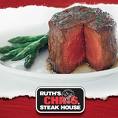 I don't pretend that I can read tea leaves, but something tells me the we'll know the wine industry has entered the healing phase when it's back to business as usual at Ruth's Chris and all of the other high-end expense account eateries in the land. I don't pretend that I can read tea leaves, but something tells me the we'll know the wine industry has entered the healing phase when it's back to business as usual at Ruth's Chris and all of the other high-end expense account eateries in the land.
I have long contended that the $100 Napa Valley Cabernet has been a direct result of the renaissance of the spendy steak house, where corporate execs like to entertain clients with expensive bottles of wine to complement their prime steaks.
Over the past 20 years the price of wine has followed the price of beef, and now both find themselves priced out of a market that is crying for relief.
So here's my dilemma. This week I tasted two outstanding Napa Valley Cabernet Sauvignons from Robert Craig, one from Mount Veeder and the other from Howell Mountain. Both were good, but the Howell Mountain was exceptionally good.>
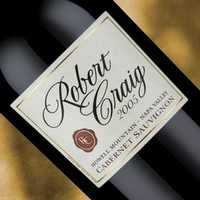 I gave it 96 points and it will be reviewed later this week on the Reviews pages of Wine Review Online. But I left both out of the tasting notes for my Creators Syndicate column this week. I gave it 96 points and it will be reviewed later this week on the Reviews pages of Wine Review Online. But I left both out of the tasting notes for my Creators Syndicate column this week.
I'm wondering who, if anyone, is still ponying up to buy $80 Cabs. In a conversation over lunch last week with Randall Grahm, he told me even selling $30 wines is a struggle in this climate.
Indeed, most restaurateurs I know are either still depleting inventory and not buying new vintages, or they're being extremely cautious with the wines they do elect to purchase.
The way I see it, something's got to give. Prices have to retreat at some point -- the only question seems to be when. I do love that Robert Craig Howell Mountain Cab, but at $80 my wallet's still in my pocket.
Posted by Robert Whitley at 2:04 PM
|
|
August 6, 2009
Call me crazy, but I've recently launched a new wine competition, my fourth. I know, there are too many wine competitions already and the economy sure isn't conducive to new ventures.
 No matter, the Sommelier Challenge is well underway. I believe in it, and am confident the Sommelier Challenge will be a huge success. The new competition will bring together a group of exceptional restaurant wine professionals to taste and pass judgment on who-knows-how-many wines the weekend of Sept. 26-27 in San Diego. No matter, the Sommelier Challenge is well underway. I believe in it, and am confident the Sommelier Challenge will be a huge success. The new competition will bring together a group of exceptional restaurant wine professionals to taste and pass judgment on who-knows-how-many wines the weekend of Sept. 26-27 in San Diego.
That's the rub with a new competition: There's no way to know what to expect in the way of entries that first year. I know because I was the founding Director of both the Monterey Wine Competition and the Critics Challenge. The San Diego International was already a mature competition when I took over seven years ago.
With the Sommelier Challenge I hope to celebrate the increased focus on wine in the modern restaurant industry. When I first started writing about wine 20 years ago sommeliers were few and far between, and the presence of a sommelier was often more intimidating than helpful.
 Not so today, as the restaurant industry has been flooded with young men and women, and chefs, too, who are passionate about wine and eager to share their knowledge and assist you on the road to discovery. Not so today, as the restaurant industry has been flooded with young men and women, and chefs, too, who are passionate about wine and eager to share their knowledge and assist you on the road to discovery.
The level of professionalism in restaurant wine service today, compared to just a few years ago, is astonishing. I believe we've recruited some of the top wine talents in the restaurant business to judge at the debut Sommelier Challenge.
And despite the scary economy, I am optimistic the timing is good. With so many new wines being released every day, I know there will be plenty of vintners eager to have their new vintages vetted by the pros as we head into the holidays. Because the majority of the competitions are staged in the first six months of the year, the Sommelier Challenge is well situated to be one of the few credible competition options at this time of year.
That's my story and I'm sticking to it.
The Sommelier Challenge judges:
Adam Curling
M Resort, Las Vegas, NV
Previous connections: The Inn at Little Washington, Citronelle, BLT Steak, KOMI
Brian Donegan
Market, Del Mar, CA
Previous connections: Arterra
Desi Echavarrie
Charlie Trotter’s, Las Vegas, NV
Previous connections: Mary Elaine's, Picasso
Jared Heber
BLT Steak, Los Angeles, CA
Previous connections: Gordon Ramsay, Bouchon, Mozza, The French Laundry, Canlis
Anani Lawson
The French Laundry, Yountville, CA
Sur Lucero
db Bistro, Wynn Hotel, Las Vegas, NV
Previous connections: The French Laundry
Andre Mack
Mouton Noir Wines
Previous connections: Per Se
Mark Mendoza
Sona, Los Angeles, CA
Previous connections: Farallon, Redwood Park
Lisa Redwine
The Shores, La Jolla, CA
Previous connections: Aqua, Liberte, Cypress Club, Grand Cafe, Molly's
Jesse Rodriguez
The Grand Del Mar, Del Mar, CA
Previous connections: The French Laundry, The Phoenician, Bouchon Las Vegas
George Skorka
BottleRock, Los Angeles, CA
Previous connections: Jonathan Club, Opus, Four Seasons Biltmore, One Pico, Crustacean
Alexander Weil
Mozza, Los Angeles, CA
Megan Yelenosky
Vela, San Diego, CA
Photo: Top, Jesse Rodriguez; bottom, Mark Mendoza
Posted by Robert Whitley at 2:09 PM
|
|
August 4, 2009
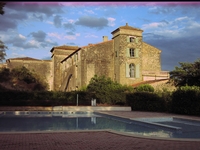 ALZONNE, France — The final leg of my summer's journey through the wine world takes me to a renovated farming estate in the south of France, about 10 miles from the medieval city of Carcassonne. ALZONNE, France — The final leg of my summer's journey through the wine world takes me to a renovated farming estate in the south of France, about 10 miles from the medieval city of Carcassonne.
This is the often-overlooked wine region of Languedoc-Roussillon, where quality has been on the rise over the past 15 years while prices continue to lag behind the more coveted wines of Bordeaux, Burgundy and the Rhone Valley. It is also the land of cassoulet, Cathar ruins, medieval castles, sunny Mediterranean beaches and the picturesque Pyrenees.
I arrived by car after a four-hour drive from San Sebastian, the seaside resort along the north coast of Spain. As I took the Autoroute from the Atlantic Ocean to the Mediterranean, I sped past turnoffs for Bordeaux and Gascony to the north and the ski resorts of the Pyrenees to the south.
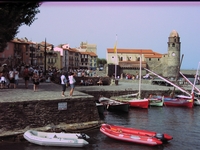 My final destination, just outside the tiny village of Alzonne and close to the slightly larger village of Bram, is located in the Cabardes zone. This is the best area of the Languedoc for the Bordeaux grape varieties of cabernet sauvignon and merlot because of the Atlantic influence, which delivers cool evening breezes that help preserve acidity and freshness. My final destination, just outside the tiny village of Alzonne and close to the slightly larger village of Bram, is located in the Cabardes zone. This is the best area of the Languedoc for the Bordeaux grape varieties of cabernet sauvignon and merlot because of the Atlantic influence, which delivers cool evening breezes that help preserve acidity and freshness.
Vineyards east of the Cabardes zone are strongly influenced by the Mediterranean, with its searing daytime temperatures and warm evenings. The Rhone grape varieties do best under those conditions, and thus are the core grapes of the Languedoc-Roussillon. Prominent appellations for this style of wine include Minervois, Saint-Chinian, Coteaux du Languedoc, Cotes du Roussillon and Corbieres.
The reds are sturdy, the whites round and generous. Though syrah is a component in many of the Languedoc-Roussillon reds, the region's strong suit is Carignan, Grenache and Mourvedre from 60- to-100 year old vines. The sumptuous whites rely upon Grenache blanc, Marsanne, Roussanne, and small amounts of Vermentino and viognier, with a smattering of other indigenous varieties.
When visiting it is wise to stick with the AOC (Appellation d'Origine Controlee) wines, though occasionally a Vin de Pays (table wine from a non-delineated region) will stand out. The Languedoc-Roussillon region is the largest wine-growing region in the world and has underperformed for most of its history. But that dynamic is changing, making it all the more compelling for the wine lover with a thirst for discovery.
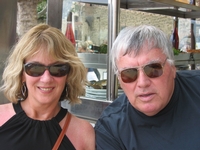 The other allure of this wine region is the history of the area. The villages near Carcassonne were once part of the sphere of influence of the Cathars, a heretical Christian sect whose fortress ruins dot the landscape. Carcassonne itself was an important fortress city for the Romans, and once withstood a long siege by Charlemagne. The other allure of this wine region is the history of the area. The villages near Carcassonne were once part of the sphere of influence of the Cathars, a heretical Christian sect whose fortress ruins dot the landscape. Carcassonne itself was an important fortress city for the Romans, and once withstood a long siege by Charlemagne.
Albi, at the northern edge of the Languedoc, is the birthplace of Henri Toulouse-Lautrec and home of the Toulouse-Lautrec museum, adjacent to the enormous Cathedrale Ste. Cecile, which had been built as a show of dominance by the Catholic Church during its showdown with the Cathars.
In the southwest corner of the Languedoc, less than an hour from my base, there is Limoux, where it is said the process for producing sparkling wine was discovered. Some locals even claim that Dom Perignon learned the secret of the bubbly while resting at the Abbaye de Saint-Hilaire in the midst of his pilgrimage to Spain's Santiago de Compostela.
They say Dom Perignon took the process back to northern France and, voila, Champagne was born!
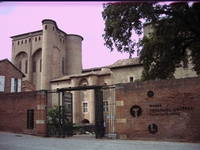 Limoux, like Cabardes, benefits from a slightly cooler climate. It sits in the foothills of the Pyrenees and is also on the edge of the Mediterranean and Atlantic influences. Limoux, like Cabardes, benefits from a slightly cooler climate. It sits in the foothills of the Pyrenees and is also on the edge of the Mediterranean and Atlantic influences.
The cool nights are perfect for the white grapes (chardonnay and chenin) of the Blanquette de Limoux. What is little known outside the region is that Limoux also produces the finest chardonnay as a varietals table wine in the entire Languedoc-Roussillon.
The region's other white table wine of note is the Picpoul de Pinet, a light, un-oaked and refreshing white that is delicious with the shellfish of the Mediterranean. I emphasize table wine, because the area is quite well known for the sweet muscats of Frontignan, too.
The Languedoc-Roussillon wine region extends from Nimes and Montpellier in the east, westward and south around the curve of the Mediterranean nearly to the border with Spain. This is where the lovely whites of Collioure and the delicious dessert reds of Banyuls are made.
The seaside village of Collioure is particularly inviting, and students of art history will recognize numerous scenes made famous by Henri Matisse and Andre Derain. And the many outdoor cafes overlooking the stunning cove of Collioure will soothe even the most discriminating palate.
Posted by Robert Whitley at 9:29 AM
|
|
August 3, 2009
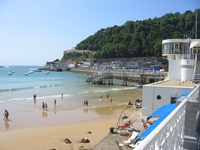 SAN SEBASTIAN, Spain — I have only checked into the Maria Cristina a few minutes ago and am already bellied up to the tapas bar at Casa Urola, in the Old Town. The streets are teeming with visitors from across the globe, drawn by the sun, the sea and the cuisine of this stunningly beautiful seaside enclave in the heart of the Spanish Basque country. SAN SEBASTIAN, Spain — I have only checked into the Maria Cristina a few minutes ago and am already bellied up to the tapas bar at Casa Urola, in the Old Town. The streets are teeming with visitors from across the globe, drawn by the sun, the sea and the cuisine of this stunningly beautiful seaside enclave in the heart of the Spanish Basque country.
This is the center of the culinary universe, for me at least. The succulent clams of this region, often prepared simply with parsley, butter and a splash of white wine, are the sweetest in the world. Grilled hake or turbot — brought in this morning by the fishing boats tied up in the port mere steps away — is so fresh and tender it melts in the mouth.
The tapas, known locally by their Basque name, "pintxos," are considered the finest in all of Spain, a point of pride among the locals and a commonly held belief I wouldn't care to debate. Fond as I am of the tapas bars that border Madrid's Plaza Santa Ana, the Old Town of San Sebastian is second to none on this score.
As I stand here at Urola and contemplate my next tapas selection, it occurs to me that this is a wine enthusiast's paradise, for this is the combination of wine and food as it was meant to be, as it should be. There are few frills: just great food and good wine.
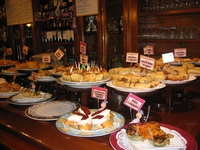 Even with limited Spanish speaking skills, it is easy to quench the palate. Red wines are "tinto," white wines "blanco" and rose wines "rosado." So I point at a "pintxo" — or, if I am feeling bold, just lift it by its toothpick and devour it in one bite — and ask for a "copa de vino blanco," or whatever my preference is depending upon the tapa I have ordered. Even with limited Spanish speaking skills, it is easy to quench the palate. Red wines are "tinto," white wines "blanco" and rose wines "rosado." So I point at a "pintxo" — or, if I am feeling bold, just lift it by its toothpick and devour it in one bite — and ask for a "copa de vino blanco," or whatever my preference is depending upon the tapa I have ordered.
It doesn't much matter what they pour. Most of the reds are Rioja crianza, while the whites are invariably Verdejo from Rueda and the rosados Garnacha from Navarro. Price for a copa of wine is cheap, typically one euro, about $1.50, in the tapas bars and one to two euros at the many outdoor cafes.
I sometimes recognize the producers, but frequently don't. Yet I almost always find the wines to be solid and quaffable, a perfect accompaniment to the array of aromas and flavor sensations I encounter even at the most modest tapas bar.
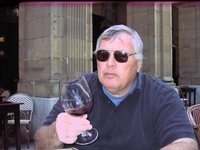 San Sebastian also boasts a number of nouvelle culinary stars, such as Arzak and Martin Berasategui, both with three Michelin stars. I've also been to Chef Berasategui's Michelin one-star in Barcelona, Lasarte, and am very much looking forward to lunch at his namesake restaurant here in San Sebastian. San Sebastian also boasts a number of nouvelle culinary stars, such as Arzak and Martin Berasategui, both with three Michelin stars. I've also been to Chef Berasategui's Michelin one-star in Barcelona, Lasarte, and am very much looking forward to lunch at his namesake restaurant here in San Sebastian.
Urola is a more traditional Old Town restaurant, with a tapas bar on the first floor, where the doors are thrown open to the crowds on the street, and a full-service restaurant upstairs, where reservations are recommended. Juanito Kojua is another traditional restaurant serving up grilled seafood and meats in the Old Town. Basque cooking is unique and you shouldn't miss the "changurro," a rich, stew-like dish made with spider crab and spooned over crusty bread.
Though Juanito is not as popular as Urola, and hence not as busy, I still suggest you make reservations before you go.
Getting to San Sebastian is the hard part, though it's not nearly as challenging as you might imagine. There are two trains a day from Madrid, and the train station is a short walk to the Playa de la Concha, where the best beaches are located, and the Centro and Old Town districts of the city. Visitors from the U.S. can make a flight connection to San Sebastian through Madrid, or it's an easy (the highways are good) five-hour drive from the Madrid airport.
Posted by Robert Whitley at 12:53 PM
|
|
 |
|